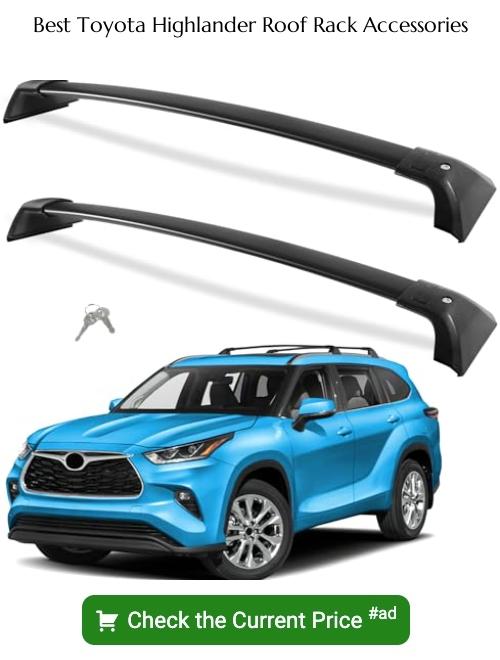Last updated on
Diving into the distinctive features of the Toyota roof rack Highlander is vital because it helps you optimize your car’s storage capacity for travel, adventure, or daily activities.
Key takeaways:
- Compatibility with Toyota Highlander model and year
- Customization options for specific activities and materials
- Benefits of genuine Toyota cross bars for secure fit and versatility
- Installation process for Toyota Highlander roof rack
- Considerations for selecting the right roof rack based on vehicle specifications and needs
Toyota Highlander Roof Rack Compatibility

When selecting a roof rack for your Toyota Highlander, compatibility is paramount. The roof rack chosen must align with the year and model of your vehicle to ensure a proper fit.
Toyota Highlanders typically have specific factory-installed roof rails, and the roof racks should be compatible with these rails.
For models without pre-installed rails, a roof rack system that can be bolted directly onto the roof is necessary.
Always refer to the vehicle owner’s manual or a Toyota dealer’s specifications to match the roof rack precisely with your Highlander’s model year and roof type.
It’s crucial to check for any restrictions on sunroofs or other roof features that might impact the installation and use of the roof rack.
Customizing Roof Rack for Highlander Models

Selecting a roof rack for your Toyota Highlander involves considering several factors to ensure it fits your specific needs. Begin by examining the model year of your Highlander; roof rack options may vary between generations.
Assess the activities you’ll engage in, from cycling to kayaking, as specialized mounts and accessories are available to accommodate different gear. For aerodynamics and noise reduction, consider a customizable system with wind deflectors.
Additionally, choose between steel and aluminum materials—steel is generally more durable, while aluminum is lighter and resistant to rust. Lastly, look at the locking mechanisms for security and quick-release features for ease of removal when not in use.
The key is to balance functionality with aesthetics for a roof rack that complements the Highlander’s lines while serving your cargo-carrying needs.
Benefits of Genuine Toyota Roof Rack Cross Bars
Opting for genuine Toyota cross bars ensures a seamless fit and compatibility with your Highlander’s roof design, reducing the risk of damage caused by ill-fitting aftermarket options. These OEM components are engineered to distribute weight evenly across the roof, enhancing vehicle stability and safety on the road.
Toyota’s cross bars are also rigorously tested for durability against environmental elements such as UV rays, wind, and rain, providing a reliable solution built to handle diverse weather conditions.
Complementing the sleek aesthetics of the Highlander, genuine cross bars integrate smoothly with its lines, maintaining the vehicle’s aerodynamics and minimizing wind noise at highway speeds. They further offer the flexibility to mount a variety of Toyota-approved accessories like bike racks, ski carriers, or cargo boxes, enabling you to customize your cargo-carrying setup for different adventures.
With a straightforward installation process, these cross bars can be mounted or removed with ease, giving you the convenience to adjust your setup as needed.
Installation Process for Toyota Highlander Roof Rack
Installing a roof rack on your Toyota Highlander involves a few straightforward steps that can be completed with basic tools. Begin by locating the factory-installed mounting points on your Highlander’s roof, which often come covered by small panels or strips along the roof rails.
Next:
1. Carefully remove these coverings using a trim tool or a flat-head screwdriver to expose the mounting points.
2. Align the roof rack cross bars with these points, making sure that the front and rear bars are positioned correctly according to the manufacturer’s instructions.
3. Hand-tighten the clamps or bolts provided with the roof rack kit onto the mounting points without fully securing them.
4. Adjust the bars so they are parallel and evenly spaced across the roof, ensuring a balanced setup.
5. Once in position, use a torque wrench to tighten the clamps or bolts to the specified torque setting as per the roof rack manual, to ensure a secure attachment.
6. Perform a tug test by carefully applying force to ensure the rack is securely attached to the roof.
Keep in mind that some roof racks may come with a lock and key system for added security, making it important to familiarize yourself with this feature during installation. Always refer to the Toyota Highlander owner’s manual for any vehicle-specific instructions or weight limitations, and consider contacting a professional installer if you have any doubts.
Determining the Right Toyota Roof Rack for Your Model
Selecting the appropriate roof rack for your Toyota Highlander requires considering several factors to ensure a perfect fit and optimal functionality:
1. Year and Trim Level: Identify your Highlander’s year and trim level, as roof rack fittings can vary between model years and specifications.
2. Existing Roof Setup: Determine if your Highlander comes with factory-installed flush side rails, raised side rails, or a bare roof. This will guide the type of roof rack system needed.
3. Purpose and Usage: Consider what you’ll be carrying. Options are available for general luggage, bicycles, skis, or kayaks, each requiring different mounts and weight capacities.
4. Load Capacity: Always adhere to the recommended weight limit provided by Toyota to prevent damage to your vehicle and ensure safe travel.
5. Aerodynamics: Choose a design that complements the aerodynamic profile of your Highlander to reduce wind noise and improve fuel efficiency.
6. Quality and Durability: Opt for a high-quality roof rack that is durable and weather-resistant to withstand the elements and protect your cargo.
7. Warranty and Support: Ensure the roof rack comes with a warranty and is supported by Toyota to maintain your vehicle’s integrity and value.
By taking these considerations into account, you’ll be able to find a roof rack system that meets your needs while maintaining the safety and aesthetics of your Toyota Highlander.
Maximizing Cargo Capacity With Highlander Roof Rack
To optimize cargo space on a Toyota Highlander roof rack, consider the following:
- Distribute weight evenly across the crossbars to maintain vehicle balance and ensure safe handling.
- Use aerodynamic cargo containers to minimize wind resistance and improve fuel efficiency on the road.
- Opt for a roof rack with an integrated locking system to secure items and deter theft.
- Select accessories compatible with the rack system, such as bike mounts or kayak carriers, to transport various sporting equipment seamlessly.
- Keep the heaviest items centered above the roof rack to avoid compromising the center of gravity.
- Regularly check the load capacity specified by Toyota to prevent overloading, which can negatively impact the roof structure and vehicle performance.
- Utilize all tie-down points provided to prevent cargo from shifting or becoming dislodged during transit.
Weight Limits and Safety Considerations
When equipping your Toyota Highlander with a roof rack, adhering to the manufacturer’s weight limit is crucial for ensuring safe travels. Exceeding the recommended capacity, which is typically around 165 pounds, can compromise vehicle stability and handling, leading to potential road hazards.
To optimize safety, evenly distribute cargo across the cross bars, keeping the center of gravity as low as possible. Before heading out, always double-check that all items are securely fastened with appropriate straps or nets to prevent any movement during transit.
Regularly inspect your roof rack for signs of wear or damage, particularly after off-road excursions or exposure to severe weather. Conscientious maintenance and thoughtful loading can help prevent accidents and extend the life of your roof rack system.
Maintenance Tips for Toyota Roof Rack Longevity
Regular cleaning is essential; rinse the roof rack with water and use a mild soap to remove dirt and grime. Avoid abrasive cleaners that can damage the finish.
Inspect regularly for signs of wear and tear, such as rust or loose components. Tighten any bolts or fasteners and replace parts as necessary to ensure secure attachment.
Lubricate moving parts semi-annually to keep them functioning smoothly. Use a silicone-based lubricant to protect against corrosion.
Avoid overloading the rack beyond its rated capacity, as this can cause structural damage and compromise safety.
If the vehicle is going through an automatic car wash, remove the roof rack to prevent any potential damage.
Store the roof rack in a dry place when not in use. If disassembling for storage, label the parts for easier reassembly.
Use only manufacturer-recommended accessories and attachments to ensure a proper fit and avoid damage to the roof rack or your vehicle’s roof.
By following these straightforward maintenance tips, you preserve the integrity of your roof rack and ensure it remains a reliable asset for your travels.
Accessories for Toyota Highlander Roof Racks
Enhancing the functionality of a Toyota Highlander roof rack is straightforward with a range of accessories designed to suit different needs. For cyclists, a bike carrier attachment ensures secure and aerodynamic bike transport. Water sports enthusiasts can opt for kayak or surfboard carriers, which come equipped with padded cradles to protect the gear. Cargo boxes and bags offer watertight solutions for transporting luggage and outdoor gear, keeping them safe from the elements.
Furthermore, special ski and snowboard carriers are available for winter sport trips, allowing for more cabin space and easy access to equipment. All these accessories are easily mounted and typically require no additional tools, providing convenience and expanding the versatility of your vehicle’s carrying capacity. It’s essential to choose compatible accessories that meet Toyota’s safety and quality standards to ensure a perfect fit and secure attachment to your Highlander’s roof rack.
Enhancing Outdoor Experiences With the Right Roof Rack Selection
Choosing the appropriate roof rack for your Toyota Highlander can markedly improve your outdoor excursions. Here’s how:
- Versatility for Gear: Opt for crossbars that accommodate a range of attachments, enabling you to carry bikes, kayaks, or skis with ease.
- Aerodynamics: Sleeker designs minimize wind resistance, leading to smoother drives and improved fuel efficiency while transporting your gear.
- Durability: Select models designed to withstand varied weather conditions, ensuring your equipment stays secure, from sun-soaked highways to mountainous terrains.
- Ease of Access: Features such as low-profile designs and integrated tie-down points can simplify loading and unloading, saving time for more adventure.
- Quietness: Some racks are engineered to reduce noise, making for a more peaceful journey as you head to your destination.
Remember, matching the right rack to your vehicle and lifestyle makes all the difference in unlocking the full potential of your outdoor adventures.
FAQ
Can you add a roof rack to a Toyota Highlander?
Yes, you can add a roof rack to a Toyota Highlander by choosing a base roof rack and referring to the Rack Attack combined fit guide or the Thule Fit Guide for the best fit.
How much can a Toyota Highlander roof rack hold?
A Toyota Highlander roof rack can hold a maximum load of 165 pounds, provided the weight is evenly distributed across both bars.
What is the difference between roof rack and crossbars?
Crossbars, typically in sets of two, run across the car’s top, while a roof rack consists of more than two crossbars and is often modular or fixed in design.
What are the disadvantages of a roof rack?
Roof racks, despite being made of lightweight materials, can still add weight to your vehicle and create drag, potentially leading to increased fuel consumption.
What types of items can safely be transported on a Toyota Highlander roof rack?
A Toyota Highlander roof rack can securely transport items such as luggage, kayaks, bicycles, skis, and cargo boxes.
Are there specific brand recommendations for a Toyota Highlander roof rack?
The Thule WingBar Evo Crossbars and the Yakima SkyLine Towers are highly recommended brands for a Toyota Highlander roof rack.
Are there any precautions to take when installing a roof rack on a Toyota Highlander?
Yes, ensure proper fitment, secure attachment, and avoid surpassing the vehicle’s roof load capacity when installing a roof rack on a Toyota Highlander.
Related
- Prius Roof Rack: Comprehensive Review and Buying Guide
- Subaru Crosstrek Roof Rack: Essential Features and Product Review
- Front Runner Roof Rack: Unbiased Review and Installation Guide
- Jeep Gladiator Roof Rack: Comprehensive Product Review for Off-road Enthusiasts
- Subaru Outback Roof Rack: Comprehensive Product Review and Guide

